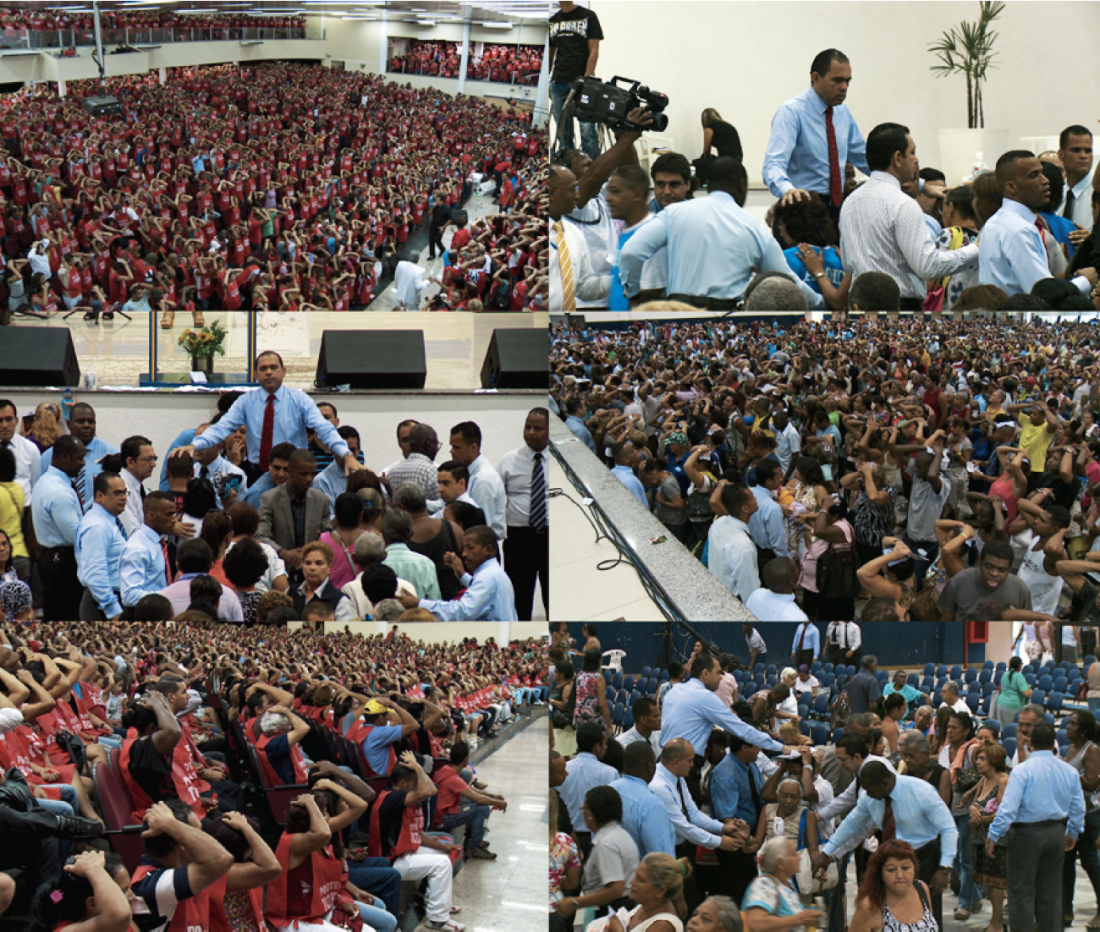Aernout Mik
When you walk into the first room of “Speaking in Tongues,” Aernout Mik’s new installation at the Haus der Kulturen der Welt in Berlin, you are greeted by a surprising duality: a riot of vision without any sound. Television screen after television screen display a global parade of religious ecstasy from arena-sized Southern Pentecostal televangelical services to prayer services in Africa, to Latin America. Torsos shaking, eyes rolling back, mouths agape, arms pumping in the air to inaudible choruses of “amen” and “praise Jesus”—an international spectacle of holy fervor, accompanied by the indifferent hum of the overhead fluorescents. The entire installation, which comprises this long row of television sets in one room and a massive two-channel projection in another, is silent, which might very well be the most important aspect of the piece.
The second room contains two screens, set up in a chevron formation. Both screens—again, silently—play out what looks to be documentation of prototypical motivational team-building business conferences; one video takes place in a massive auditorium, another in a flatly lit, anonymous office conference room. We all know the protocol of these things, if not from lived experience then certainly from television or movies. Here is a roomful of suited men and women, a collection of sober adults in suits and skirts and pressed shirts being subjected to platitudinous slogans, grating neologisms and childish role-playing games in an effort to motivate them…to what, exactly, I never understood (this is perhaps why I could never keep an office job longer than six weeks).
In fact, the latter two videos are staged by Mik, and his recreation of these corporate circuses are so convincing that if I didn’t recognize some artist friends in and amongst the suits, I would have thought this was yet more documentary footage. We never hear anything: the slogans being uttered, or the morale-building speeches being delivered; the phrases on the whiteboard without context (bullet-pointed, starred and underlined) are too vague to glean meaning from.

Aernout Mik, Speaking in Tongues, 2013, video still, multi-channel video installation. Courtesy the artist and carlier | gebauer, Berlin.
Instead, we watch the demonstrations, the role-playing games, the call-and-responses. Both videos skirt the edges of verisimilitude, until, almost imperceptibly, the behaviour of the participants slides out of reality. Or, more accurately, they slide out of one reality and into another. The auditorium entropically descends into animalistic chaos: balloons drop from the ceiling, the men and women leave their seats and start dancing, praying and flailing, their minds and bodies seemingly no longer their own. The conference room members, on the other hand, play out their silly games until they run out of steam, and the office workers, trapped in this fluorescent-lit purgatory until God only knows when, lie down on the floor, slump against the walls, and wait out the clock. All of which happens in complete and total silence.
The silence creates a kind of commensurability between the documentary footage and the staged performances. I don’t tend to think of the corporate world and evangelical fanaticism as being at all equivalent, let alone on the same spectrum but as I cycled between videos and between rooms, I understood the nature of my mistake: it is not that Mik has forced a kinship here, it is that intelligible speech forces an artificial divide. I hear a man in a suit on stage talk in tongues, and his formally dressed audience des-cends into shrieking fits; I relegate these goings-on to the realm of the irrational. I hear a man in a suit on stage talk about synergies and performance objectives, and his formally dressed audience call back affirmations at his behest, and I relegate these goings on to the realm of (blandly) rational.
But Mik provides no access to what’s being said, either in the documentary footage of the ecstatic religious services, or in the business meetings, and so these distinctions can’t be made and what’s more important, neither can dismissals. I am left with a procession of videos of men in suits holding sway over their respective formally dressed audiences. What remains is an interchange of extreme passions, a series of gestures robbed of verbal signifiers, a literal going through the motions—gesticulations, heavy strides across stages, hands to the sky, collapsing to the ground; a kind of a dance.
The didactic material at the Haus der Kulturen der Welt talks about the commensurability between the corporate world and the religious world—and the bleeding incorporation of each others’ respective rites and rituals in terms of capitalist critique—and this isn’t incorrect. Capitalism is a religion and religion is big business. Whether a roomful of people are being incited to be more profitable for the sake of the supremacy of their brand, or a roomful of people are being incited to invest their money for the sake of the security of their souls, the methods are the same. But there is a larger point here. The dance that Mik both displays and choreographs is a much older, broader dance: it is the dance of the mob. Stripped to its essential parts, bereft of any kind of distracting aural accompaniment, “Speaking in Tongues” lays bare the score of mass hysteria. ❚
“Speaking in Tongues” was exhibited at Haus der Kulturen der Welt, Berlin, from November 15, 2013 to January 12, 2014.
Sholem Krishtalka is an artist and writer currently based in Berlin. His latest project, A Berlin Diary, is published regularly on Hazlitt, Random House of Canada’s culture website.

